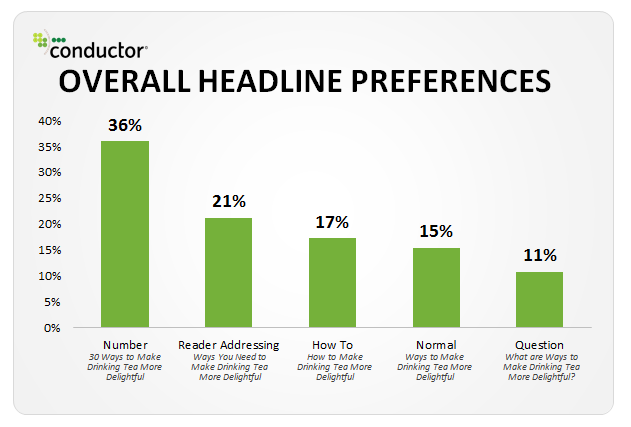In today’s competitive online world, writing engaging titles for your content is critical for success. A good title can make all the difference in whether your content gets noticed, shared, and ultimately, drives traffic to your website. Here’s a guide on how to write engaging titles that will not only captivate your audience but also boost your search engine optimization (SEO) efforts.
Keyword-Rich Titles
One of the most important things to consider when writing engaging titles is incorporating keywords. Keywords are terms that people use to search for information online. By including them in your title, you increase the chances that your content will show up in search engine results pages (SERPs). However, be careful not to overuse keywords as this could result in a penalty from search engines.
Use of Odd-Numbered Title
Numbers in headlines have been proven to drive the most clicks, with 36% of people showing a preference for them. This is 15% higher than the second preferred headline style, “reader-addressing.”

According to a study by Conductor, readers are drawn to numbers in headlines because they give them a clear indication of the number of components they can expect to see in the article.
Not only do numbers grab attention, but odd numbers have been shown to perform better than even numbers. The reason for this is that odd numbers are perceived as more trustworthy. People tend to assume that an odd number of items on a list is more accurate, as even numbers are seen as more convenient.
While it’s perfectly acceptable to use even numbers in headlines when it fits the tone of the article, incorporating odd numbers can result in higher engagement rates.
In addition to numbered headlines, it’s important to mix things up with a variety of headline styles, such as how-to posts, questions, and general articles. This helps to keep the content fresh and engaging for readers.
Boost Your Blog’s Reach with Power Words in Titles
In a sea of online content, writing engaging and eye-catching titles for your blog posts is crucial for standing out from the competition. With nine search engine results and hundreds of posts vying for attention in social media feeds, you need to make an impact.
Power words can help you do just that by creating an emotional connection with your audience and getting them to pause and click on your content.
Power words evoke strong emotions and create vivid mental images that draw readers in, without resorting to deceptive clickbait tactics. Instead, they offer enough of a hook to pique the reader’s interest and generate excitement about the content.
Some of the most effective power words include: “powerful,” “surprising,” “amazing,” “unbelievable,” “mind-blowing,” and “exclusive.” These adjectives add flavor to your titles and generate stronger feelings, making your readers emotionally curious about what lies beyond the catchy headline.
Remember, adjectives are descriptive words such as “fantastic,” “unforgettable,” and “captivating.” By incorporating these into your headlines, you’ll be well on your way to crafting powerful and attention-grabbing titles that will drive traffic to your blog.
Question-Based Titles
Are you looking to write engaging and attention-grabbing blog titles? Ask questions! Titles that pose questions can be highly effective in capturing the reader’s interest and enticing them to click through.
By targeting the questions that your target audience is asking, you can increase your chances of getting their attention. Furthermore, if the question implies that your post will provide a solution to their problem, the likelihood of them clicking through to your content increases even more.
However, it’s crucial to make sure that the question can’t be answered with a simple “yes” or “no.” Instead, aim for questions that require them to engage with your content to find the answer.
Here are some examples of effective question-based titles:
- “Is Your Tennis Game Struggling? Here’s How to Fix Common Serve Mistakes”
- “How Do You Determine When to Replace Your Dog’s Food Bowl?”
- “Want to Live 7 Years Longer? Discover the Secrets of These Studies”
- “Ready to Start an Online Business Using Only ChatGPT? Here’s How”
- “Tired of Low Traffic? Boost It by Changing These 3 Simple Things”
Another great formula to use for question-based titles is the “Who Else Wants [Something]” formula. These types of titles evoke a sense of community and help to build a connection with the reader.
Some examples include:
- “Who Else Wants to Live an Extra 7 Years? These Studies Explain How”
- “Who Else Wants to Start an Online Business Using Only ChatGPT?”
- “Who Else Wants More Traffic by Changing These 3 Things?”
Sell The experience
We all know that benefits are important, but what’s even more impactful? The experience!
While benefits are valuable, describing the experience behind them can make all the difference in attracting potential customers.
Here’s a comparison to illustrate this point:
Benefit-focused: These 7 Adjustable Dumbbells Will Save You Space at Home
Experience-focused: 5 Ways Adjustable Dumbbells Simplify Your Muscle-Building Journey The first title highlights the space-saving aspect of adjustable dumbbells, which is a clear benefit.
However, the second title focuses on the experience of using adjustable dumbbells and how they make muscle building easier, adding a new layer of excitement and intrigue to the product.
This approach also piques reader’s curiosity, making it an even more effective headline.
Pain points in your blog titles
An Effective Tool for Crafting Engaging Titles Highlighting pain points in your blog titles can be much more impactful in attracting readers than emphasizing pleasure. Research shows that people are twice as motivated by pain than by pleasure.
By poking at the reader’s pain points, you can create an engaging and attention-grabbing title that they can’t resist. Here are two examples:
“9 Blogging Blunders You Could Be Making and How to Correct Them”
“5 Hidden Threats to Your Garage’s Security You Need to Know”
The first title addresses the common mistakes bloggers might be making, triggering their curiosity to find out what they might be doing wrong.
The second title warns the readers about potential threats to their garage security, arousing their concern and interest to read more and find out what they need to do to protect their garage.
Make it Compelling and Unique
In addition to being keyword-rich, your title should also be compelling and unique. Your title should grab the reader’s attention and make them want to click through to read your content. Consider using numbers, questions, or intriguing phrases to make your title stand out.
Command Attention with Precision in Headlines Nailing down the details in your headlines is a proven strategy to establish trust and authority in your niche.
The more precise you are, the more you’ll be recognized as an authority in your field.
Several copywriting formulas emphasize the importance of Specificity, including the 4 U’s and the 5 S’s frameworks.
The 4 U’s formula includes
- Urgency
- Uniqueness
- Usefulness
- Ultra-Specificity
where the latter emphasizes that ultra-specific headlines, content, emails, and ads tend to perform better than generic copy.
The 5 S’s framework includes
- Solicitude
- Selflessness
- Specificity
- Stickiness
- Solidarity
where Specificity is a key aspect of creating headlines that connect with your audience and drive engagement.
Here’s an example to make titles more engaging:
Generic: “5 Ways to Use the Keto Diet for Brain Health”
Specific: “Keto Diet and The Brain: How to Use Keto to Improve Mood and Cognitive Performance”
Generic: “Keto Meal Prep: How to Plan and Prepare Your Week’s Meals”
Specific: “Keto Meal Prep 101: Plan and Prep a Week of Keto Meals in Under 3 Hours”
Add Dates in Headlines for More Engaging Titles
Including the date in your headlines adds relevance and a sense of timeliness to your content, making it more appealing to readers. It also demonstrates your commitment to providing accurate and up-to-date information, increasing trust and credibility.
However, the use of dates in titles varies depending on the subject matter. For instance, a title such as “Morning Routine for Ultimate Productivity” may not require a date, as it’s considered timeless content. On the other hand, a title about the latest Black Friday deals must have a date for relevancy.
To simplify the process, utilize dynamic title variables in your SEO plugin. For example, in Rank Math, use %current_year% and in Yoast, use %%currentyear%%. If your content is highly competitive, adding the month to the title may be beneficial for a fresh perception. Remember to update the posts as needed for continued relevancy.
Focus on Curiosity
Titles that spark curiosity are a surefire way to increase traffic, subscribers, and revenue for your content.
But you don’t have to resort to clickbait titles like “You won’t believe what happens next!”
Here’s how to craft intriguing titles without the cheesy clickbait:
Examples:
- Discover Why These 3 Dog Leads are Selling Like Hotcakes
- The Surprising Secret to My 473% Increase in Blog Traffic
Tips for writing engaging titles with a touch of curiosity:
- Make a bold statement. Don’t be afraid to show off your accomplishments.
- Leave some mystery in the title. The example above about dog leads hints at why they’re selling so well, but the reason is only revealed in the post.
- Use intriguing language to pique the reader’s interest.
- Deliver on your promise. If you don’t, readers will lose trust in your content.
- ADD A PROMISE Incorporating a promise in your title adds an extra layer of value for the reader.
While many titles already have an implied promise, you can make it more appealing by adding specifics.
Examples:
- 11 Steps to Self-Publish a Kindle Book in 5 Days or Less
- 7 Ways to Speed Up WordPress and Boost Organic Traffic
Both of these titles offer not only information on the main topic, but also a desirable outcome.
Test your Titles
Finally, it’s important to test different versions of your titles to see which ones perform best.
This process, known as A/B testing, involves using tools or services to compare the performance of different titles.
In WordPress, you can use Nelio A/B Testing (a premium plugin) or Google Optimize (free for 5 simultaneous experiments and integrates with Google Analytics).
Experiment with different variations of your titles, and let the tools show you which ones perform best.
Keep it Short and Sweet
While it’s important to be descriptive in your title, it’s also crucial to keep it short and sweet. Titles that are too long tend to get truncated in SERPs, which could lead to a less effective title. Aim for a title that is no more than 60 characters.
Use Emotional Appeal
Emotional appeals are a great way to make your title more engaging. By tapping into the reader’s emotions, you can increase the chances that they will click through to read your content. Consider using words like “inspiring,” “heartwarming,” or “shocking” to evoke an emotional response.
Consider Your Target Audience
Finally, it’s important to consider your target audience when writing engaging titles. Your title should appeal to the people you are trying to reach and reflect the topic of your content. Understanding your audience will help you craft a title that resonates with them and drives traffic to your website.
The Power of Engaging Titles in Driving Traffic
The importance of writing engaging titles cannot be overstated. A good title can make all the difference in whether your content gets noticed, shared, and ultimately drives traffic to your website. By incorporating keywords, making it compelling and unique, keeping it short and sweet, using emotional appeal, and considering your target audience, you can write engaging titles that boost your SEO efforts and drive traffic to your website.
In conclusion, writing engaging titles is a critical part of your content marketing strategy. By following the tips outlined in this guide, you can write titles that not only grab the reader’s attention but also boost your SEO efforts and drive traffic to your website.



